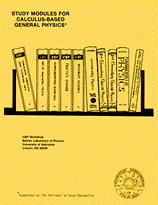Instructional Materials in Physics and Astronomy

Calculus-Based General Physics
Date of this Version
1975
Document Type
Article
Abstract
Anyone who has ever grabbed an automobile spark-pluq wire at the wrong place, with the engine running, has an appreciation of the ability of a changinq current in (part of) a coil of wire to induce an emf in the coil. What happens is that the breaker contacts open, suddenly interrupting the current, and causing a sudden large change in the magnetic field through the coil; according to Faraday's law, this results in a (large) induced emf. In general, the production of an emf in a coil by a changing magnetic field due to a current in that same coil is called self-induction; and the ability of a coil to produce an emf in this way is commonly measured by its self-inductance L, usually called more briefly its inductance. A coil used in this way is more formally called an inductor.
The transmission of electric signals by television, radio, and telephone depends on time-varying currents and fields to represent the appearance of pictures and the sound of voices; and so, as you can well imaqine, capacitors and inductors play an important role in the circuits of such devices. You already know that a capacitor can store energy; so can an inductor. If an inductor carrying a current is connected to a resistor, its energy is dissipated as heat in the resistor, much as for a charged capacitor. But now suppose you connect it instead to a capacitor; the inductor will try to give its energy to the capacitor - and vice versa - but the initial energy is not quickly dissipated from the electrical circuit. What do you suppose happens? If you do not already know, can you guess, before studyinq this module?


Comments
From Study Modules for Calculus-Based General Physics
Copyright © 1975 CBP Workshop, University of Nebraska–Lincoln.
Reproduction rights granted.